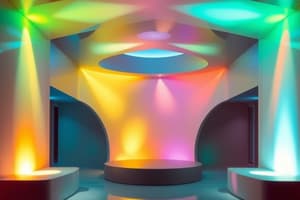Podcast
Questions and Answers
What describes the density of luminous flux striking a surface?
What describes the density of luminous flux striking a surface?
- Light loss factor
- Luminance
- Lumen output
- Illuminance (correct)
Which lighting design practice focuses on providing a balance and variety to add interest to the space being illuminated?
Which lighting design practice focuses on providing a balance and variety to add interest to the space being illuminated?
- Illuminance design
- Ambient lighting design
- Task lighting design
- Architectural lighting design (correct)
What is the approximate maximum spacing-to-mounting height ratio referred to as?
What is the approximate maximum spacing-to-mounting height ratio referred to as?
- Light loss factor
- Luminance ratio
- Luminaire spacing ratio
- Spacing criterion (correct)
Which type of lighting is essential for reducing eye fatigue while reading and writing in offices or studies?
Which type of lighting is essential for reducing eye fatigue while reading and writing in offices or studies?
Which factor contributes to the reduced light output of a lighting installation over time?
Which factor contributes to the reduced light output of a lighting installation over time?
What is one primary purpose of accent lighting?
What is one primary purpose of accent lighting?
Which type of lighting might use low voltage halogen spotlights for its application?
Which type of lighting might use low voltage halogen spotlights for its application?
What is an important consideration for lighting in restrooms and bathrooms?
What is an important consideration for lighting in restrooms and bathrooms?
Which type of lighting is described as the most essential because it provides the basic background of light for almost every room?
Which type of lighting is described as the most essential because it provides the basic background of light for almost every room?
Which design practice was historically common for providing all the lighting in a space?
Which design practice was historically common for providing all the lighting in a space?
Flashcards are hidden until you start studying
Study Notes
Lighting Concepts
- Luminance is the luminous intensity of a surface in a given direction, per unit of projected area of the surface.
- Illuminance is the density of luminous flux striking a surface.
- Lumen output (LM) is generally based on the number of lumens initially output by each lamp.
- Light loss factor (LLF) is the product of all considered factors that contribute to a lighting installation's reduced light output over a period of time.
Design Principles
- Architectural lighting design is a blend of science and art, requiring a thorough evaluation of existing installations and the application of scientific principles in creating new designs.
- The main goals of designing an aesthetically pleasing architectural lighting system are to provide sufficient quantity, quality, and balance of light.
Lighting Types
- Ambient lighting is the most essential form of lighting, providing the basic background of light for almost every room, and can come from sources such as fluorescent, halogen, and incandescent.
- Task or local lighting illuminates a specific visual function, making work easier on the eyes, and focuses light in a particular direction or area without casting glare.
- Accent lighting adds drama and emphasizes a particular object or area, and can be achieved using low voltage halogen spotlights, track lighting, or picture lights.
- Decorative lighting aesthetically adds interest to the space by blending with other types of lighting to give an overall feel.
Design Considerations for Specific Spaces
Entrances
- The entrance or foyer is the transitional space from public to private and exterior to interior, and offers the first impression of a home or building.
- Lighting should draw attention to the building entry.
Offices/Studies
- Reading and writing require quality lighting that limits eye fatigue caused by glare.
- This space can take advantage of a beautiful vista out the window and good natural ambient light daylight.
Restrooms/Bathrooms
- The best light washes the face from all directions, softening shadows.
- There should be sufficient light to see detail for grooming but not so much to cause glare and discomfort.
Dining Spaces
- No specific design considerations mentioned.
Studying That Suits You
Use AI to generate personalized quizzes and flashcards to suit your learning preferences.




